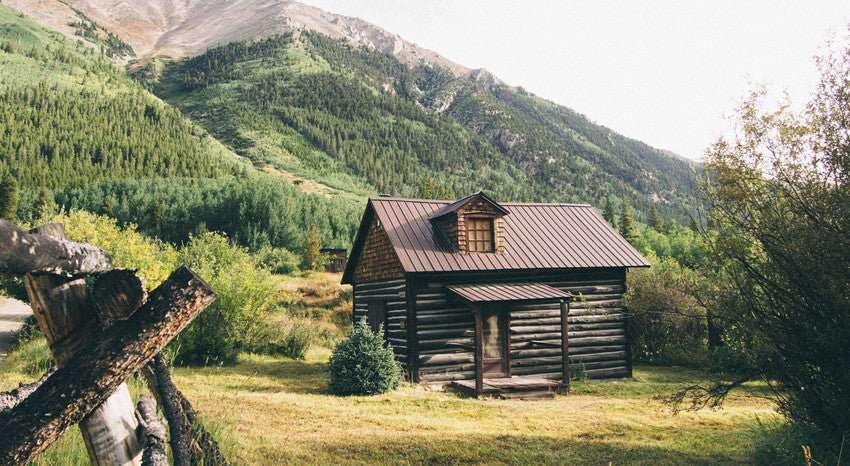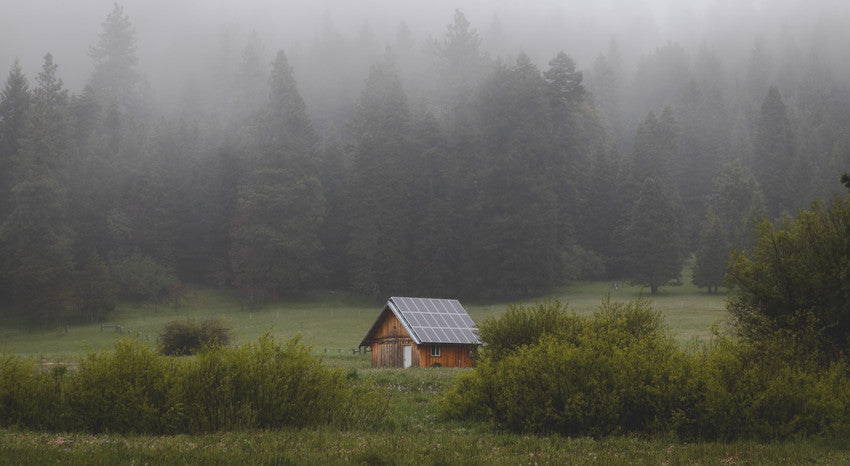How Can I Power My Off-Grid Cabin?
How Can I Power My Off-Grid Cabin?

Building an off-grid cabin can be an exciting adventure. It helps you disconnect from the noisy outside world, get away from it all, and spend quality time with your thoughts and those who matter most to you. But many people are not willing to give up some of the comforts of their homes, such as water, sewer, and electricity. So how do you keep the lights on in your off-grid cabin? You may have more choices than you may think.
Off The Traditional Grid
Before we work on making the cabin off-grid, it is crucial to understand exactly what is meant by off-the-grid. Off-grid homes or other structures are designed to operate without being connected to the traditional utilities and other systems that ordinary homes rely on. This means an off-grid cabin will need to produce its electricity, harvest and treat its water, and manage its waste. All of these systems present their challenges, which will vary based on the location and climate of the cabin.
What Do Off-Grid Cabins Need Electricity For?
Depending on the owners’ preferences, an off-grid cabin requires only a small amount of electricity for essentials such as lights, heating or cooling, and potentially a water pump. In this case, homeowners can build a relatively low amount of electricity generation capacity of a few hundred watts per hour.
However, the higher the level of comfort in your home, the more power you will need. Cabins with multiple appliances, electronics, or other equipment will need more electricity, sometimes significantly more. If you are considering your own power needs, you can find the wattage used by various items either printed on a label on them or online.
How to Power the Off-grid Cabin?
So how exactly do you get the coffee flowing in your off-grid paradise? There are some options, each with its benefits and costs. Here are the most popular choices.
Battery Bank
A lithium iron phosphate (LiFePO4) battery bank can be a vital part of your off-grid cabin life, however, it will require to work in concert with another energy source. Batteries charged by solar panels, wind, hydro, and conventional electricity can be connected to the off-grid power system. The system will draw electricity from the batteries bank as needed. This can go a long way toward powering your basics of the off-grid home.
Solar Energy
Solar energy perhaps is the most common type of off-grid and renewable energy source, most people should have at least heard of solar panels. The large, shiny blue or black panels absorb the energy from the sun’s rays and convert it into electricity. You can mount your solar panels permanently on a place like a top roof or use portable panels that you can move as needed.
Cabin owners can add an almost unlimited number of solar panels and scale up their systems to fit their daily needs and budget. The biggest downside is that they will not produce any electricity for you at night and generate less on cloudy days or in certain climates. Still, Still, they are one of the most common off-grid cabin electricity systems because of their relative ease of installation and usability in most places.
Wind
For off-grid cabins in breezier spots, the wind can also create power energy. Like any other windmill, wind turbines use blades to catch the wind, which turns a turbine to produce electricity. While turning every passing breeze into power might seem appealing, wind turbines don’t generate electricity until the wind reaches a certain speed, known as the cut-in speed.
Windmills also have a cut-off speed where they will shut down to protect themselves if winds blow too fast. This can mean you may not create as much power energy from wind as you might expect. Nonetheless, this system can be an excellent option for windy locales, especially ones where solar energy or other off-grid energy types won’t do enough on their own.
Micro-Hydro Energy
The Micro-hydro system uses the same concept as the big hydroelectric dam you may have seen, it is just scaled down for personal use. The water is diverted from the river, the stream, or other waterways. It flows down an alternate channel where the waterwheel converts the energy of water into power energy.
These are the least common off-grid cabin setups, primarily due to this setup needs to be near water and it is difficult to build and maintain a hydro system.
Generator
Most people are familiar with generators, whether they're in a power outage at home or as a way to keep the lights on while camping or away from the grid. While they can provide a decent amount of reliable power, they are best as a short-term option only.
Many generators struggle to power an entire home for an extended period and will need large amounts of gas. This forces owners to stock up on gasoline and deal with the air and noise pollution that most generators create.
The Most Important Part of the Off-Grid Cabin Power Setup: Batteries
Whether you are using solar, wind, or water energy, one thing is true you are not guaranteed to have energy created at any given time. For solar, you won’t be generating at night, and windless days or droughts can leave those relying on wind or hydro in the lurch. Thankfully, a good battery bank can resolve this problem. Battery banks will store the energy created by your system in times of excess to use in times of need.
But there is a lot more to a battery bank than just hooking up any old battery. Many homeowners choose flooded lead-acid batteries, they are the cheapest and most inefficient of the deep-cycle batteries. While these can save you money upfront, they require regular maintenance to operate correctly and need to be replaced every few years.
Other lead-acid batteries such as AGM (absorbent glass mat) require no maintenance. But they cost more and come with other lead-acid drawbacks like difficulty operating at high or low temperatures. You also have to be careful how deeply you discharge these batteries.
Off-Grid Cabin in Winter
Alternatively, those looking to build an off-grid cabin battery bank can choose the newest battery technology, lithium-iron phosphate (LiFePO4) batteries. Lithium batteries are maintenance-free, work well at nearly all temperatures, can be almost completely discharged (80% - 98%), and also charge more quickly than their lead-acid batteries counterparts. (LiFePO4 batteries can work well in temperatures within -4°F~140°F.)
Even better, they are lighter and smaller and can last years longer than traditional batteries. While they are likely more expensive initially, many people find the cost worth it for the reduced hassle, increased capacity, and longer-lasting equipment.

Best Off-Grid Power Source: Solar Energy
Solar power is unquestionably the top option for those looking for reliable electricity for their off-grid cabin getaway. Unlike battery banks or generators, solar energy is renewable, clean, and endlessly available as long as the sun shines.
Meanwhile, wind power and micro-hydro can present problems in finding a suitable site, purchasing equipment, and ensuring a steady flow of electricity. Solar energy also offers the benefit of being one of the most commonly available off-grid power systems, which means more affordable parts and installation and more options.
How Many Solar Panels Do You Need for your Cabin?
This will again depend strongly on the location of the cabin and the electricity you need. Solar panels can vary widely in the energy they create. The small solar panel creates less than 100 watts per hour in ideal conditions. It is crucial to understand your energy needs to size your solar panels and batteries properly. It is also generally good to add additional capacity if your budget and design allow it.
Can a Cabin Run on Solar Power Alone?
Though it may not be easy. Especially for those with moderate to low power requirements, it is completely possible to power a cabin solely on solar. Typically, homeowners need to invest in a significant number of solar panels and ample battery storage. Batteries can be used to power the cabin when the natural sunlight is not ideal for power generation.
Running solely on solar power will be easier for those in sunny climates. They can take full of the sun’s energy. However, those people who need large power or in locations that don’t receive much sunlight may find this power source difficult.

Conclusion
Today, more and more people choose the outdoor off-grid life which is almost becoming a trend, but it is a challenge to solve the power system needed for daily life. There are also various strategies for the power system. Generally, with the sun, wind, water, and more, there is no need for traditional electrical infrastructure. But the best choice for most people should be clear. A solar power system with a battery bank is the most cost-effective, versatile electrical system for your off-grid cabin.


















![[Upgraded Version] Enjoybot 14.6V 20A Waterproof Mountable LiFePO4 Lithium Battery Charger For 12V LiFePO4 Battery](http://enjoybot.com/cdn/shop/files/14.6V_20A_Waterproof_Battery_Charger_1_360x.jpg?v=1752565609)
![[Upgraded Version] Enjoybot 14.6V 20A Waterproof Mountable LiFePO4 Lithium Battery Charger For 12V LiFePO4 Battery](http://enjoybot.com/cdn/shop/files/14.6V_20A_Waterproof_Battery_Charger_2_360x.jpg?v=1752637374)















